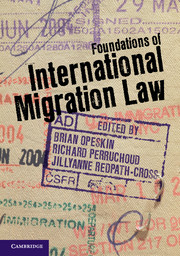Book contents
- Frontmatter
- Summary contents
- Detailed contents
- Preface
- List of case studies
- List of boxes
- List of figures
- List of maps
- List of tables
- Notes on contributors
- Abbreviations
- 1 Conceptualising international migration law
- 2 Contemporary patterns of international migration
- 3 Sources of international migration law
- 4 Nationality and statelessness
- 5 State sovereignty and freedom of movement
- 6 International human rights of migrants
- 7 Refugees and asylum
- 8 Women, children and other marginalised migrant groups
- 9 Human trafficking and smuggling
- 10 International migration by sea and air
- 11 International labour migration
- 12 International trade law and labour mobility
- 13 Global migration institutions and processes
- 14 Regional processes, law and institutional developments on migration
- 15 Emerging legal issues in international migration
- Appendix 1 Cases
- Appendix 2 Treaties and other international instruments
- Glossary
- Index
- References
5 - State sovereignty and freedom of movement
Published online by Cambridge University Press: 05 November 2012
- Frontmatter
- Summary contents
- Detailed contents
- Preface
- List of case studies
- List of boxes
- List of figures
- List of maps
- List of tables
- Notes on contributors
- Abbreviations
- 1 Conceptualising international migration law
- 2 Contemporary patterns of international migration
- 3 Sources of international migration law
- 4 Nationality and statelessness
- 5 State sovereignty and freedom of movement
- 6 International human rights of migrants
- 7 Refugees and asylum
- 8 Women, children and other marginalised migrant groups
- 9 Human trafficking and smuggling
- 10 International migration by sea and air
- 11 International labour migration
- 12 International trade law and labour mobility
- 13 Global migration institutions and processes
- 14 Regional processes, law and institutional developments on migration
- 15 Emerging legal issues in international migration
- Appendix 1 Cases
- Appendix 2 Treaties and other international instruments
- Glossary
- Index
- References
Summary
Sovereignty allows States to regulate the movement of persons within and across their borders. It is a power that should not be exercised to the detriment of individual human rights. While the liberty to move freely and in a lawful manner is by no means absolute, limitations imposed by a State should be justified, necessary and proportionate to the state interest. This chapter outlines the concept of sovereignty under international law, the right of States to admit and expel persons, and the regulation and facilitation of migratory movements. By providing an overview of the international legal framework, it analyses whether any significant advancement has been made since the end of the nineteenth century, particularly on the right to leave and the right to return.
STATE SOVEREIGNTY AND CONTROL OF EXTERNAL BORDERS
The concept of sovereignty, first understood as the supreme and absolute autonomy over a particular territory, evolved from being an ‘omnipotent authority’ to a totality of legal powers and competences regulated by contemporary international law. As a concept of international law, it comprises three major aspects – external, internal and territorial – each being exercised in accordance with the rules of international law. The external aspect of sovereignty concerns the relationship between States: it is the right of a State to determine freely its relations with other States or entities without the restraint or control of another State. This aspect of sovereignty is also known as independence. The internal aspect of sovereignty is the State’s right or competence to determine the character of its own institutions, to enact laws of its own choice, and to ensure respect for and adherence to national laws. The territorial aspect of sovereignty is the authority that a State exercises over all persons and things found within its territory, as well as over its nationals abroad.
- Type
- Chapter
- Information
- Foundations of International Migration Law , pp. 123 - 151Publisher: Cambridge University PressPrint publication year: 2012
References
- 9
- Cited by



